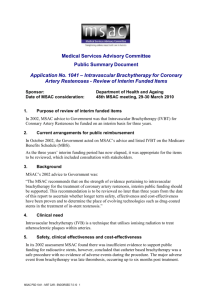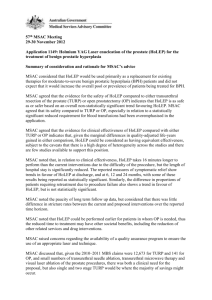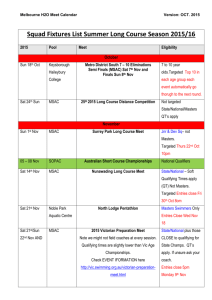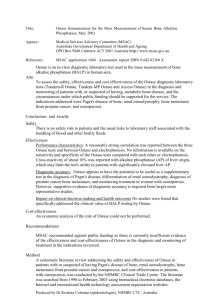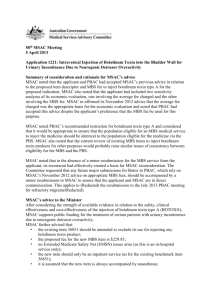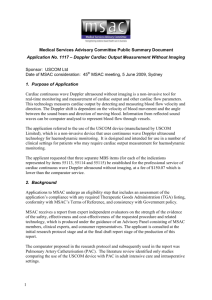superceeded (Word 67 KB - the Medical Services Advisory Committee
advertisement
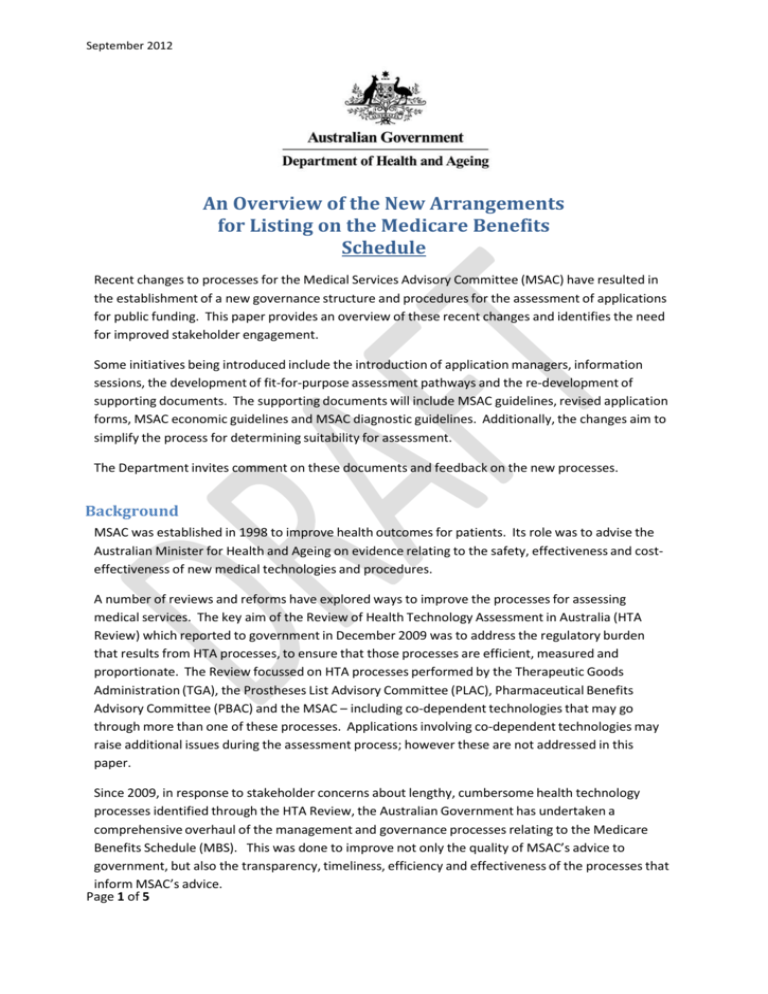
September 2012 An Overview of the New Arrangements for Listing on the Medicare Benefits Schedule Recent changes to processes for the Medical Services Advisory Committee (MSAC) have resulted in the establishment of a new governance structure and procedures for the assessment of applications for public funding. This paper provides an overview of these recent changes and identifies the need for improved stakeholder engagement. Some initiatives being introduced include the introduction of application managers, information sessions, the development of fit‐for‐purpose assessment pathways and the re‐development of supporting documents. The supporting documents will include MSAC guidelines, revised application forms, MSAC economic guidelines and MSAC diagnostic guidelines. Additionally, the changes aim to simplify the process for determining suitability for assessment. The Department invites comment on these documents and feedback on the new processes. Background MSAC was established in 1998 to improve health outcomes for patients. Its role was to advise the Australian Minister for Health and Ageing on evidence relating to the safety, effectiveness and cost‐ effectiveness of new medical technologies and procedures. A number of reviews and reforms have explored ways to improve the processes for assessing medical services. The key aim of the Review of Health Technology Assessment in Australia (HTA Review) which reported to government in December 2009 was to address the regulatory burden that results from HTA processes, to ensure that those processes are efficient, measured and proportionate. The Review focussed on HTA processes performed by the Therapeutic Goods Administration (TGA), the Prostheses List Advisory Committee (PLAC), Pharmaceutical Benefits Advisory Committee (PBAC) and the MSAC – including co‐dependent technologies that may go through more than one of these processes. Applications involving co‐dependent technologies may raise additional issues during the assessment process; however these are not addressed in this paper. Since 2009, in response to stakeholder concerns about lengthy, cumbersome health technology processes identified through the HTA Review, the Australian Government has undertaken a comprehensive overhaul of the management and governance processes relating to the Medicare Benefits Schedule (MBS). This was done to improve not only the quality of MSAC’s advice to government, but also the transparency, timeliness, efficiency and effectiveness of the processes that inform MSAC’s advice. Page 1 of 5 September 2012 Following a public call for comment in 2010 on proposed changes (including those recommended in the HTA Review) key reforms to the MSAC assessment process were introduced on 1 January 2011. These included new terms of reference for MSAC and the establishment of two sub‐committees; the Protocol Advisory Sub‐Committee (PASC) and the Evaluation Sub‐Committee (ESC). The government’s dedication to the broader role of MSAC was reinforced in the 2011 Budget through the announcement of the Comprehensive Management Framework for the MBS (CMFM). Under the CMFM, MSAC will not only provide advice on new medical services involving technologies and procedures, but on all proposed changes to the MBS. Details of the new assessment process are under the heading Summary of the New Process. Ongoing stakeholder engagement Many of the changes are as a result of feedback requesting increased transparency and consultation during the assessment of medical services. The Department is committed to ongoing stakeholder engagement, and has built‐in stakeholder consultation at several points in the new process. In addition, stakeholder engagement on key areas of the process is planned as implementation continues. Individuals or groups with an interest in commenting on issues proposed for MSAC’s consideration may register to receive email alerts notifying them of all opportunities for consultation. The increase in publicly available information about applications and opportunities for comment are a considerable step towards increased transparency. Where it is appropriate/helpful, stakeholders will be provided with support on how to lodge their application and will have opportunities to be walked through the MSAC process. The Department will hold information sessions on the MSAC reforms where stakeholders will have the opportunity to discuss any issues and provide feedback on the MSAC process. Applications will be managed by a specific application manager throughout the process. The reforms to MSAC processes require both the revision of current documentation and development of some new documentation. The Department will seek comment from stakeholders on revised application forms, MSAC guidelines, MSAC economic guidelines and MSAC diagnostic guidelines. Next Steps The process described in Summary of the New Process is appropriate for full health technology assessments. The next steps include developing fit‐for‐purpose pathways for assessment, consistent with MSAC’s new terms of reference. The expanded role of MSAC has resulted in a range of different applications being subject to MSAC processes: new technologies/services; reviews of existing MBS items; and amendments to existing items. It has become evident that not all applications will require the high level of scrutiny involved in a full Page 2 of 5 September 2012 MSAC process. It is intended that the processes to support a proposal will correspond with the clinical and financial risk of the proposal. Fit‐for‐purpose approaches to the assessment of applications can be applied, where appropriate. Such fit‐for‐purpose approaches will allow the MSAC process to offer applicants the flexibility to request an expedited approach. It should be noted that there is a risk that the evidence submitted may be deemed inadequate. In such a case, the application would need to be resubmitted. The Department will continue to develop a range of fit‐for‐purpose assessment pathways and will seek feedback from stakeholders as this development progresses. The Department is also working on improvements to co‐dependent technology assessment, with the aim that a common application form be used for applications that are considered by both MSAC and the PBAC. Improved communications and closer stakeholder engagement is a major priority for the Department. The Medical Benefits Division has been restructured and the Medicare Financing and Listing Branch has been created. This Branch is responsible for the administration of MSAC, Medicare data, analysis and costings. A section has also been created with a specific focus on stakeholder engagement. A dedicated team of staff from this section will be responsible for the case Management of each application and will provide a single contact for applicants throughout the MSAC process. Summary of the New Process The new assessment process is focussed on increasing consultation and transparency and ensuring the MBS supports cost‐effective, evidence‐based best practice care. The new process allows for stakeholder consultation during the assessment of items for listing on the MBS. The process occurs in four broad stages: determination of suitability for assessment, development of the research question/s, assessment of evidence, and MSAC appraisal. These stages are detailed below: 1. Determination of suitability for assessment The steps that occur during this stage are explained below and are designed to limit the burden on the applicant. i. Potential applicants may request an initial meeting or attend an information session with Departmental representatives. Initial meetings allow potential applicants to ask questions about the process and discuss the proposed service with relevant representatives from the Department. ii. The applicant is asked to submit preliminary information to ensure the proposal meets the requirements for consideration for public funding. This includes the provision of evidence from relevant peak bodies that this is a necessary and appropriate part of practice. At this step, the Department also assigns an ‘application manager’ to support the applicant through the process. The Department also commences identification (or recruitment) of particular clinical or other expertise to the MSAC Expert Standing Panel (MESP) to provide subject matter advice on the proposal, and to the Protocol Advisory Sub‐Committee (PASC). Page 3 of 5 September 2012 2. Development of research question/s This stage allows the applicant and the wider community to have input into the scope of the assessment for applications. i. Once the proposed application is deemed suitable for assessment it is listed on the MSAC website and the applicant is requested to submit further information to enable PASC to determine the research question for public funding by proposing a Decision Analytic Protocol (DAP). The DAP sets out the clinical management algorithm that specifies both the clinical and economic evidence required to inform MSAC’s appraisal. A draft DAP is developed by an external evaluation group for consideration by PASC. The applicant is provided the opportunity to comment on the draft DAP before PASC’s consideration. ii. The draft DAP is considered and amended (where necessary) by PASC and published on the MSAC website for public consultation providing an opportunity for all interested parties to comment on the proposed assessment approach. The MSAC secretariat will also approach relevant professional bodies for comment during public consultation. iii. The final step in this stage is for PASC to review the outcomes of the public consultation and determine the final DAP. 3. Assessment of evidence There are two assessment pathways an applicant can choose once the DAP has been finalised, either a contracted assessment (CA) or a submission based assessment (SBA). A CA is when an applicant agrees to the Department contracting an assessment group with expertise in health technology assessment to gather the evidence which addresses and supports the research questions for public funding. An SBA is when an applicant gathers the evidence which addresses and supports the questions for public funding as outlined in the final DAP. The Department will then undertake a contracted ritique of the SBA. An applicant may choose to go down the path of an SBA as it is likely to expedite the process. An assessment of the evidence is undertaken, by either the assessment group for a CA or the applicant for an SBA. An assessment report, which provides evidence and analysis to address the issues identified in the final DAP, is provided to the Department for the consideration of the Evaluation Sub‐Committee (ESC). The form of the assessment report is specified in the MSAC Guidelines to ensure that all elements that need to be considered by MSAC and its sub‐committees are addressed. The ESC considers the assessment report and identifies the main issues and uncertainties that MSAC may need to specifically appraise. ESC produces a written report summarising these issues, which is made available to the applicant for comment. Both the ESC report (and applicant comments) and the assessment report are provided to MSAC. 4. MSAC appraisal The final stage in the process is MSAC’s appraisal of the evidence presented in the assessment and Page 4 of 5 September 2012 ESC reports to inform its advice to government. MSAC prepares a detailed rationale for its conclusions in the form of a ‘public summary document’ (PSD). After the Minister has noted MSAC’s advice and agreed to its public release, MSAC’s advice, the PSD, and the assessment report will be made available on the MSAC website. Where specific material is agreed to be confidential, the report will be published with the confidential material redacted. The Department offers debrief meetings to applicants following the public release of MSAC’s advice. Following MSAC’s consideration, the Department of Health and Ageing is required to consider the financial impact to government, consult with the Department of Finance and Deregulation, seek Cabinet agreement and draft and implement legislative change before an item can be amended or added to the MBS. The introduction of new opportunities for public comment and increased public release of assessment documentation provides a significant increase in the transparency of listing processes for the MBS, and greater opportunity for input and feedback from interested parties. Page 5 of 5
